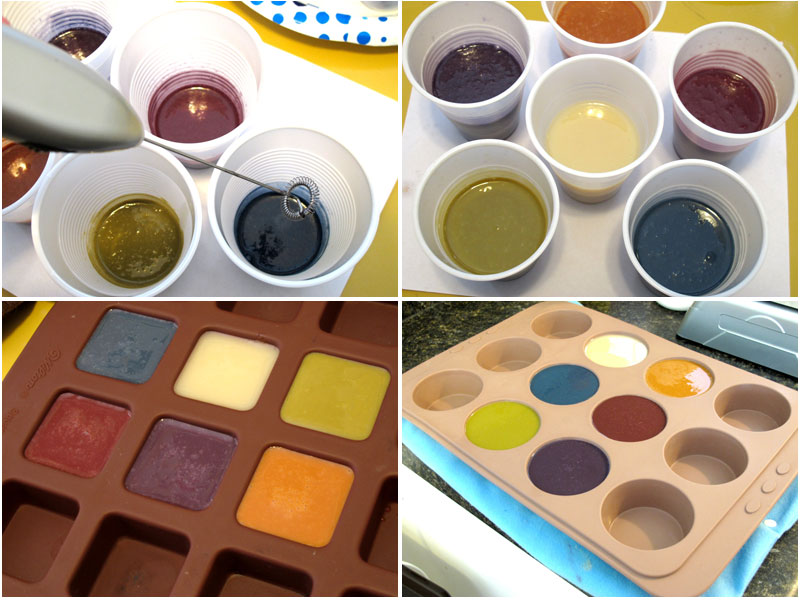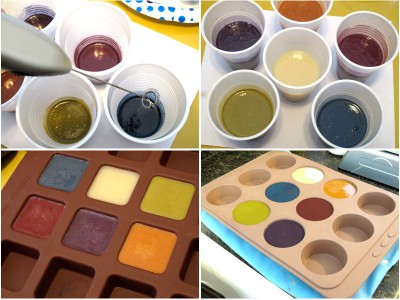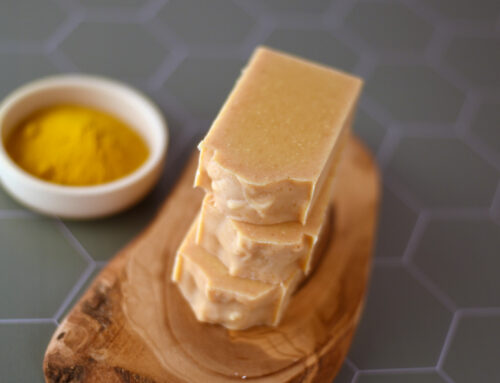One of my favorite things to do as a soap maker is to mix colors! I’m by no means an expert but I wanted to share how I mix, test and use colors. In this post we’ll focus on oxides and ultramarines. Oxides and ultramarines are my favorite type of colorants to use because they are stable, easy to predict (what you see is usually what you get) and they don’t usually fade, bleed or cause other issues. The only problem I’ve had with them is using too much and having it come off on a wash rag…especially reds. So I’m going to show you my process for coming up with and testing new color combos.
During this tutorial I only use yellow oxide, brick red oxide and ultramarine blue. That gives us our base colors of red, blue and yellow which we can mix to create a rainbow of colors. It’s good to have a little color theory knowledge. I might go into that in a future post but for now do a little research on color theory and paint mixing and you’ll find some great info online.
First we need to setup our base colors. People color mix two ways. They simply mix dry powders or they wet/suspend them and then mix them. I prefer mixing wet. I just think it’s easier to see what you’re going to get and to also add additional parts of a color if needed. I simply mix about 8 tablespoons of glycerin with 2 tablespoon of pigment. I didn’t have glycerin today but used sunflower as it’s a nice light oil. You can even do 4 tablespoons glycerin to 2 tablespoons pigment; just a matter of preference. Give these a good mix. I love using the little frothers. I buy mine at Ikea but I think Bramble Berry might sell them also. The pigment will start to sink down if left alone too long so always give it a good mix before you start measuring them out into the little cups to color mix.
Now for the fun part! Its time to mix colors! I like to mix colors in the little plastic bathroom cups. I use teaspoons and keep track of “parts” so the color recipe is easily scaled up or down. For example if I want to mix a purple, I will measure 3 teaspoons of blue and 3 teaspoons of red into a little cup. These are equal parts so the color recipe is 1 part red and 1 part blue. Be sure to keep track of the parts; I like to write on the cups with a marker to keep track.
Where do you start? Some simple and common combos are blue and yellow to make green or blue and red to make purple. I start with equal parts and then go up or down to create different hues.
For example, take a look at the colors below. The one on the left is 1 part blue and 1 part red. The one on the right is 5 parts red and 2 parts blue. Usually I would have flipped that and done a 2 parts red and 5 parts blue…but I didn’t this time. You can be methodical or just throw parts into a cup to see what you come up with! Have fun with it!
To get a better idea of the color you can dab a little onto a paper towel.
Once I get the colors where I want them, I test them in MP. This gives me a better idea of how it will come out. My soap recipe is not as white as MP but it is pretty white. You can skip testing it in MP if you want. I just prefer too. Here you can see I’ve tested them in MP.
Then it’s time to test in CP. Use your standard recipe. Please note that the colors of your oils will affect the colors you end up with. My recipes tend to be pretty white, barely creamy. Some people use olive oils that have a green tint to them. This is why it is important to test. I usually test about 5 colors at a time so I make a 1 pound test recipe. I use a silicone muffin pan as a mold. I also like to see what the color difference will be between ungelled and gelled soap. Gelled soap seems to be more vivid and slightly darker. So I use a heating pad to force gel on the muffin pan and I’ll pour little sample sized amounts into a brownie pan which will not gel. This way I can see the color difference between gelled and ungelled…simply a matter of preference.
I’ll also test them to see if the lather is colored. If it is…I’ll know to use less next time. Usually I only have this issue with reds.
So here are some color recipes that turned out great.
From left to right:
(1) Green – 1 part ultramarine blue / 4 parts yellow oxide
(2) Blue – 3 parts ultramarine blue / 1 part yellow oxide
(3) Purple – 1 part ultramarine blue / 1 part brick red oxide
(4) Maroon – 5 parts brick red oxide / 2 parts ultramarine blue
(5) Orange – 2 parts brick red oxide / 4 parts yellow oxide
(6) No color
(Ignore all of the ugly bubble marks in the pic above. I mixed using the frother and that just added tons of bubbles.)
I went a little heavy handed with the colorants. I used about 1 teaspoon of the mixed color per 4 oz of raw soap. I kinda thought the maroon would bleed/have colored lather but it actually didn’t. See below.
Once you find color combos that you like…you can make up bigger batches of them and keep them in bottles already mixed and ready to go.
Do you have any oxide/ultramarine combos that you really like? If so…let us know so we can give them a go!
-Amanda













can this procedure be used in concrete vessels? or would it best to use the combos mixed in with the cement all mixture and see what colour it makes?
Wow!!!! Great information. Thanks so much!!!
Thanks for this great tutorial ! I am excited to try some of these colors.
You should take part in a contest for one of the best websites on the
net. I most certainly will recommend this web site!
Hi, my CP soap is pretty yellow. Could you post your recipe? I’d love to have a whiter soap to start off with! Thanks a million!
Great tutorial!! Thanks!
Where can I find the oxides to make the colored soap??
Great post! I think I will use your maroon and purple in my Fig soap for Christmas! Has anyone found color blending charts or recipes for oxides and micas? I found two, one at TBK Trading and at diycosmetics.com. Are there any more out there? Happy Soaping everyone!
I have found sifting to be extremely helpful with powdered pigments.Once I realized that they tend to clump!Just use a small wire strainer and the back of a spoon to push through if need be.It depends on the humidity where you live.This has made using pigments easy.
please subscribe me
I love this tutorial/post. This is a great resource for coloring soaps, very in depth.
I featured this post on my website with a link! http://makeyoursoap.com/natural-soap-colorants/
For true red you may want to consider using a Gel Color. Gels don’t bleed like Labs do and they’re deeper than most micas and oxides. And the big plus is you can actually mix gel and oxide colored soaps. So for example do a red and gold soap. Use gel for red and oxide for yellow and they will play nicely together.
I have several oxides and ultramarines I was wondering how to make a brighter green then what you have there ? any helpful tips?
I hardly know anything about soaping, only been at it for 4 months, but I know enough to realize that it took a great deal of time for you to put this tutorial together, and I truly appreciate it. Someone gave me a sample of blue oxide and now I know how to measure and mix it into my hot process soap. You have wonderful teaching abilities and this ‘way beyond senior’ has benefited greatly from them today, a sincere thank you.
jean
Love your blog! My question is in regards to the oils or glycerine- are these factored onto the oils of the recipie?
Desde España, gracias Amanda. No uso mucho los colorantes en mis jabones, pero así explicado, creo que me animaré pronto. Gran tutorial. Un saludo.
Very nice information, I from Haiti I you will be doing training there, I like to know more about it.
Couple questions – I have a problem getting Ultramarine blue to break down when mixing the powder into anything. I mostly mix into glycerine and I use a frother but still get little chunks that refuse to break up. Any ideas? Also do you think storing premixed colors in squirt bottles (like the ketchup and mustard bottles you use on picnics but are see through instead of yellow and red) would work? Not sure how well you could shake it up before each use.
Any thoughts would great. Thank you, Leigh
Hi Leigh, that is interesting about ultramarine blue. I will have to mix some of mine tonite and see how it works. I don’t recall having issues. I do like to premix colorants in glycerin and storing in bottles. The squirt bottles would work. You do have to mix them well before use…so keep that in mind.
Fantastic tutorial, thank you very much for all of us eager to learn anything “soap”.
Hilda Bahner
Hi Amanada,
Great post, I am new to soap making and tend to get more adventerous than I probably should. Over the Winter I want to start a “Football – College & Pro” Line for my craft shows. I need to get a grip on the coloring aspect of my CP soap so I don’t mess up to badly.
My son has been bugging me for Steeler’s colored soap Black & Gold so guess I will have to print out your tutorial and order some UltraMarines and Oxides then get mixing.
I did a multi colored cp peacock swirl last night with ruby red grapefruit JUICE (unsweetened) as my sole liquid with my lye–so far so good…put it in oven 1-1/2 hrs @ 170 to set all night. Beautiful vivid reds!
I noticed on Ellen’s Essentials there is a Peacock dye called Ruby Red that is supposed to be a Christmas red in CP. I haven’t tried it so I can’t state positively it will be a true red. I just thought I’d mention it.
Great tutorial. So grateful for people like you who so graciously share their knowledge and time. Thank you!
Dear Amanda,
Could you wright names of you pigments or where it is possible to buy them?
Thank you, Katy
Hi Katy, I used ultramarine blue, brick red oxide and yellow oxide – all from Bramble Berry 🙂
are you saying we can add glycerin -mixed colorants we’ve got in our bottles (pre-mixed) to our cold pour recipes? Or am I just doing some wishful thinking?! Can you email my response? I really appreciate your great customer service, by the way:)!
What an incredible tutorial, Amanda! Thanks for sharing your expertise. =)
Wow! this is great! I love using pigments but am bad at mixing colors..this is a great help..Thanks! 🙂
Hello everybody,
I love your blog, it is always a pleasure to discover your new ideas!
I have a hint (is it the right word? excuse me, I am from Germany) for the “Santa Claus Red”.
Here in Germany, we have a pigment, it is called Acid Red, the CI is 16255, it is water soluble.
When you mix it to your soap, it gets brown, but don’t worry, after the gel you’ll get a wonderful Santa Red.
Hope you can buy it at your local stores.
Bye Bye and thank you for the blog
Petra
THanks! I’ll see if I can find that color here. 🙂
Nice tutorial Amanda. I’m still fooling with the palm free. I use UMPink and Yellow oxide for a pretty coral color. I mix dry and don’t keep notes on the ratio. I’ll do that in the future! Thank you for the inspiration.
Pam
Hello,
I am French and I make soaps and cosmetics for 3 years.
I just discovered your blog and I find it very beautiful. Congratulations.
Sincerely,
Lucie
What do the parts stand for? Are they in cups, ounces?
Thank you.
You can make the parts whatever you want them to be depending on how much color you want to mix up. So if you have something that is 1 part blue and 2 parts yellow then you can either measure out 1 teaspoon blue and 2 teaspoons yellow or you can measure out 1 tablespoon blue and 2 tablespoons yellow. The proportions remain the same.
What a great post, can’t wait for the next Color Palette!!
Regarding a nice “santa” red, the Tomato Red liquid colorant sold by Nature’s Garden is pretty spot on.
I love using pigments, too. And I’m amazed how you got all those great colors starting with just blue, red and yellow! I never would have guessed. Nice job!
Thanks, Ruth!!
Do you mix your pigments and store them for future use or mix what you need for each batch of soap?
Hi Tina – for colors that I really like…I make up a little squeeze bottle so that it is already mixed and ready to go.
Since water is added , with this mixture require a preservative?
Hi Pam,
Actually water isn’t added…its liquid glycerin. The colors will be good for the shelf life of your glycerin which is usually about a year.
Oh my goodness, I had water in my mind…clearly this states glycerin…thanks.
Really handy way of doing it. Nice tip!
Great post, Amanda!
I really liked the tones of lime and blue you get. Gonna try it soon.. Thank you.
Thanks for publishing this tutorial. Your blogs are really quite helpful.
What a great tutorial!
What a fantastic post. As a fellow blogger I know it took a lot of time to photograph all your colorants and your soap and I appreciate that. I don’t currently use oxides but if I do in the future I will certainly come back to this post. Great job!
Thanks, Donna!
Great way to create new colors. I have problems getting a true red, santa claus red. The micas I get work great but gave me a darker color more like a burgandy, the red oxide as well. Is there a way to get a nice santa red?
Thanks
Rey
Star Light Creations
Puerto Rico
Hi Rey! It really hard to get a true red in CP because you are starting out with a cream opaque base. But if anybody has any ideas, please let us know!
I get a Christmas Red with Amethyst Pink from The Sage. Ingredients- D&C Red 30 Alum Lake. It is a dry powder and sounds like it should bleed, but I use enough to get a Christmas Red and it doesn’t bleed.
Hi, so nice to see a Puertorrican here! I am also from P.R (Aguadilla) but currently living in LA, California. To get a good, pretty true red I mix red oxide with Fired Up Fuchsia from Brambleberry. I really like the results in CP.